Wide Screen Weekend 2003 |
Read more
at in70mm.com The 70mm Newsletter |
|||||||
| Written and photographed by: Thomas Hauerslev | April 2003 | |||||||
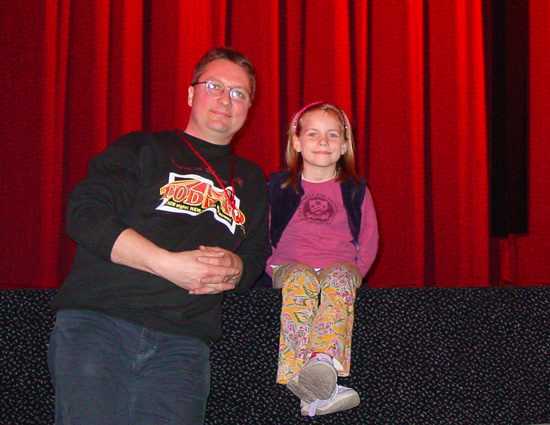 The
editor, Thomas Hauerslev and daughter Maria on the edge of Pictureville's
massive Cinerama red curtain. Picture by Paul Rayton. The
editor, Thomas Hauerslev and daughter Maria on the edge of Pictureville's
massive Cinerama red curtain. Picture by Paul Rayton.The annual Widescreen Weekend (a component of the larger Bradford Film Festival) in Bradford, England, took place March 21-24, 2003. I will try and explain some of the Pictureville highlights as I observed them to give those of you not attending an idea of what happened. Hopefully you will be so intrigued as you read this, that you won't be able to resist the temptation to attend next year! For one annual weekend since 1995, Bradford in West Yorkshire becomes the "widescreen center of the world" when 70mm and rarely screen classics are celebrated. The Widescreen Weekend is open to everyone interested to see the wonders of the big screen in the best possible conditions at Pictureville cinema. The 3-day event is well established among the regular audience who come year after year and stay for the whole weekend. This core audience is a dedicated group of 70mm and Cinerama enthusiasts, with at least one common interest; To see the old films at least one more time. And we "regulars" cannot emphasize enough to you potential new visitors how interesting all this can be. The events are well behind us now and I can look back at three exciting days with my 8-year old daughter Maria. This was her first film festival and she was a pleasure to travel with. She’s no stranger to movies, as I’ve always tried to show her the wonder of seeing films in real cinemas. A habit she is used to since age 1. I’ve taken her to Hamburg (Germany) and Malmö (Sweden) to see 70mm films. In Bradford, she watched a lot of films, and had a ball. 2003 is the 50th anniversary year of the launch of anamorphic CinemaScope projection for commercial motion pictures. And so it was decided to devote a bit more screen time to this process this year, and a little less 70mm. |
Further
in 70mm reading: Widescreen Weekend 2003 • Gallery: 2003 • Gallery film: 2003 • Gallery film: Greenhalgh • Gallery film: Rayton • WSW Home • Through the Years • The Best of WSW • Academy of the WSW • Creating the WSW • Planning the WSW • Projecting the WSW • Home of CINERAMA • Projecting CINERAMA Internet link: |
|||||||
Friday, March 21, 2003 |
||||||||
 Usually I arrive in Bradford on the Friday, but this year it was Thursday. This year we stayed at the Hilton, which is very close to the cinema. Maria and I did some shopping Friday morning before our first film,
"Cyberworld 3D". Maria became dizzy from wearing the IMAX 3D glasses and I must admit the film was rather boring and the glasses were uncomfortable. She slept two hours Friday afternoon. The trip from Copenhagen, a foreign country and all the new faces, drained the energy from her. Usually I arrive in Bradford on the Friday, but this year it was Thursday. This year we stayed at the Hilton, which is very close to the cinema. Maria and I did some shopping Friday morning before our first film,
"Cyberworld 3D". Maria became dizzy from wearing the IMAX 3D glasses and I must admit the film was rather boring and the glasses were uncomfortable. She slept two hours Friday afternoon. The trip from Copenhagen, a foreign country and all the new faces, drained the energy from her.In the evening we saw "2001: A Space Odyssey" in 70mm on the Cinerama curve. It was spectacular to see it again - yet I suddenly realized how much I felt the film was dated. It never struck me before, but I felt the film's furniture, clothing and interior design (compared to real-life MIR and space shuttles) looked much more "1960s" than ever before. I remember seeing "2001: A Space Odyssey" in 1978 at age 15, and it made a huge impact on me although it took me several years to figure out the plot. At that time, the year 2001 was not to come for another 22 years. Suddenly, 2001 is now two years ago, and the film seems dated to me. Incidentally, the cutlery used in "2001: A Space Odyssey" is called "AJ" and dates back to 1959. Danish architect Arne Jacobsen for the Royal Hotel in downtown Copenhagen designed it. It is still available for purchase relatively cheap. We have it at home and use it every day. The performance was very well attended, about 2/3 sold out. Projection was straightforward no-nonsense 70mm with spot-on sharpness. The print was fine with minor beating and scratches to it, but it was nice to know it was film, and not some sort of digital humbug. It was presented in Dolby SR 6-track magnetic sound. |
|
|||||||
|
||||||||
50th Anniversary of CinemaScope |
||||||||
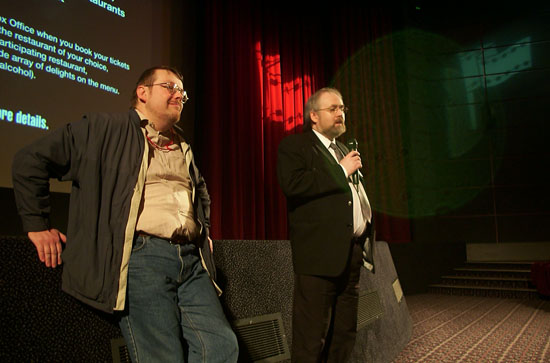 Head
of Cinema, Mr. Bill Lawrence (right) introduces Mr. Hans Helf of
Germany.
Picture by Thomas Hauerslev. Head
of Cinema, Mr. Bill Lawrence (right) introduces Mr. Hans Helf of
Germany.
Picture by Thomas Hauerslev.Saturday, March 22, 2003 German film fan-extraordinaire Mr. Hans Helf had brought his collection of CinemaScope trailers along for the weekend, and charmed the audience with a very amusing introduction. For nearly two hours the Pictureville audience was treated with to CinemaScope and anamorphic trailers. Many forgettable titles and a few pleasant surprises for me, like "Where Eagles Dare", "A Star is Born" and the Technirama logo one of the trailers. Here's a full list of all trailers: "A Star is Born", "Green Star", "Storm over the Nile", "To Hell and Back", "The Sun also Rises", "A Time to Love and a Time to Die", "The Naked and the Dead", "Night Passage", "Porgy and Bess", "In Harms Way", "Bunny Lake is Missing", "Hurry Sundown", "´The 4 Horsemen of the Apocalypse", "Is Paris Burning", "Lancelot and Guinevere", "H.M.S. Defiant", "Hawaii", "The Molly Maguires", "Zulu", "Khartoum", "Where Eagles Dare", "The Music Lovers", "Kidnapped", "Julius Caesar", "Earthquake", "Raise the Titanic", "Alices Adventures in Wonderland", "Blue Thunder", "The Living Daylights and "Star Trek IV". |
||||||||
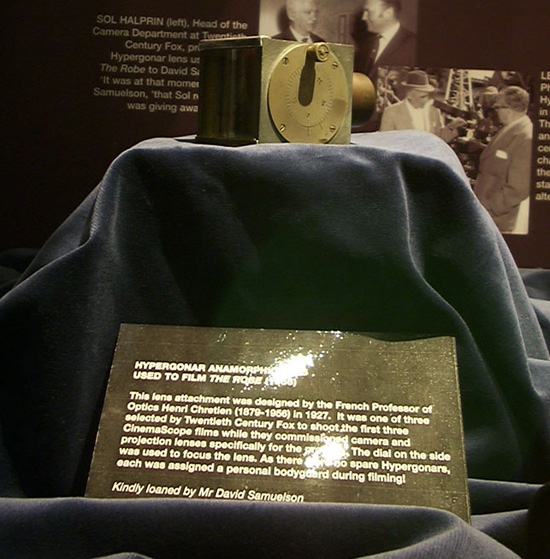 The
original CinemaScope lens used to photograph "The Robe"
on display in the foyer. The
original CinemaScope lens used to photograph "The Robe"
on display in the foyer.David Samuelson: A Lifetime with the Movies Mr. Helf explained how all films in native Germany are dubbed, so his trailers mostly originate from nearby Switzerland. 30 trailers were nearly too much, but can you really criticize this once-in-a-lifetime opportunity to see so many anamorphic trailers? Not really. Mr. Helf personally thought the two hours a "short film"; he's obviously used to 10 hours of serious movie viewing. They are of course a bit eccentric those Germans. Mr. Helf is to be thanked for his efforts collecting these mementos of movie life, and for bringing them to Bradford. He received very large warm applause for his introduction. |
||||||||
Technical Seminar "Wide screen lenses old and New" with Joe Dunton about anamorphic lenses |
||||||||
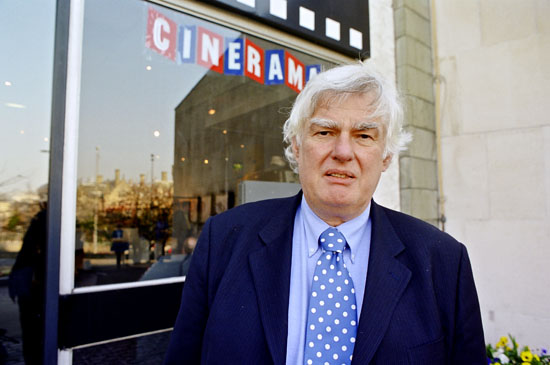 Joe
Dunton. Picture by Thomas Hauerslev Joe
Dunton. Picture by Thomas HauerslevMr. Joe Dunton, (J.D.C. Scope lenses) presented a fascinating insight of today's problems getting producers to photograph in the 35mm anamorphic format. Mr. Dunton had brought a selection of his lenses along. Mr. Dunton´s company JDC Lenses is much like Panavision. He has 10 complete sets of lenses ready for hire (Panavision has 40 by comparison). To end the seminar he gave an example of just how good a new print can look. The first clip was "The Mission" (1985). The image was very fuzzy and dull to look at. The next clip was a third-generation (camera negative (1), interpositive (2) and cinema print (3)) print from "The Life of David Gale" (2002). The image quality was stunning, very sharp and pleasant to look at. 20 years ago Mr. Dunton filmed the hip-hop film "Dance Craze" in super 35mm and blew it up to 70mm. Mr. Dunton now is planning to bring a 70mm print to Bradford for 2004. |
||||||||
Cinerama's "Search For Paradise" |
||||||||
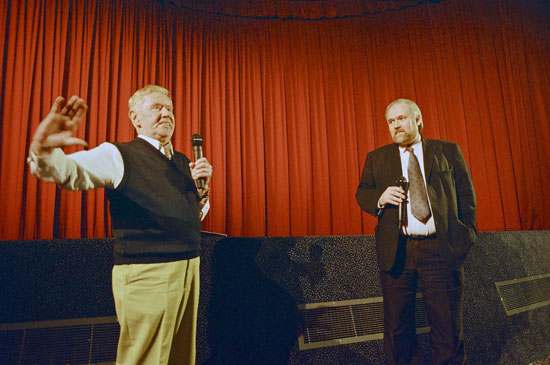 Howard
Rust introducing Cinerama. Bill Lawrence (Right) looking happy. Picture by
Thomas Hauerslev Howard
Rust introducing Cinerama. Bill Lawrence (Right) looking happy. Picture by
Thomas HauerslevNext in line Saturday was the 3-strip Cinerama travelogue, "Search For Paradise" (1957) (4th film in the series), not seen in England (or anywhere else for that matter) for nearly 45 years. It was the least successful of all 3-strip Cinerama films. It "only" ran 34 weeks at the premiere run at the London Casino, Cinerama devotee Mr. Keith Swadkins informed me. Nevertheless, I looked forward to seeing it. The incredible sharp pink print (Official Cinerama Colour) came from John Mitchell in Australia and was recently shown in Seattle at the Cinerama Theatre. Mr. Mitchell is the person who has a complete set of 3-strip prints and a Cinerama set-up in his back yard. The print wasn't particularly scratched considering the age but it was terribly buckled. Cinerama fan number #1 and Widescreen Weekend Academy member, Mr. Howard Rust introduced the film to a half full cinema. Lowell Thomas explained the reason for the making of "Paradise" in the Technicolor prologue. When the time came and the Cinerama red curtain opened and opened and opened ... the film broke! It’s a situation the Pictureville audience is used to, because a "breakdown film" is then shown. Besides, you have to expect the occasional interruption like that with prints that old. At projection rehearsal, the film didn't break, projectionist Roger Brown later told me. The buckled condition of the print caused the center panel film to break at start-up. The colour breakdown film was mirrored/flipped in the projector and quickly abandoned. Pictureville obviously needs a breakdown-breakdown film. At any rate, once "Paradise" really began, there were no more problems. Maria and I sat in the 1st row to be able to enjoy the incredible resolution and first person experience of Cinerama. She was probably more interested in the ice cream she ate. |
||||||||
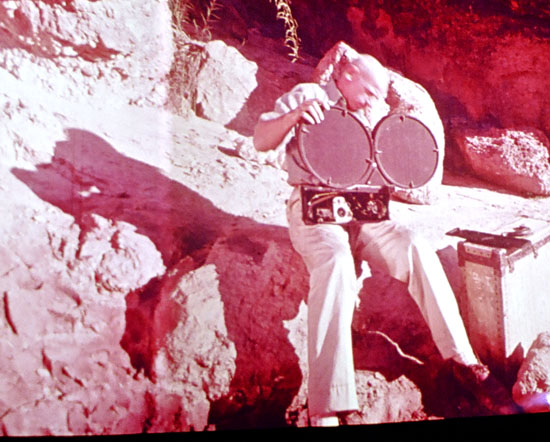 Perhaps the most interesting sequence was the Indus River rafting with the "S.S. Cinerama" inflatable rubber boat. There were many shots of the camera crew and cameras preparing for the rafting sequence. The other thing I found amusing were all the local people in seen by the camera, who constantly were looking into the 3-headed monster with amazement and surprise.
"Search For Paradise" is piece of Americana from the 1950. Propaganda, really, promoting the ideas and values of the American way of democracy. Although several scenes were breathtaking to see, I think
"Search For Paradise" was, overall, embarrassing, racist at times and boring (especially the first half). It was endless shots of trekking into the Himalayas. Thomas even says "Another day at the trail" during the first half. At one point I felt the film was just going around in circles. The story line was incredibly thin, to the point of non-existent. Clearly running out of a story line,
"Search For Paradise" became a film about its own making. Lowell Thomas even co-wrote the song about himself as sung in the film! This was too silly, and a clear indication of why Cinerama was eventually turned into 70mm. In Denmark,
"Search For Paradise" wasn’t even shown. It’s a shame Waller´s Wonder wasn’t refined and developed in order to be used for a line of dramatic films. Perhaps the most interesting sequence was the Indus River rafting with the "S.S. Cinerama" inflatable rubber boat. There were many shots of the camera crew and cameras preparing for the rafting sequence. The other thing I found amusing were all the local people in seen by the camera, who constantly were looking into the 3-headed monster with amazement and surprise.
"Search For Paradise" is piece of Americana from the 1950. Propaganda, really, promoting the ideas and values of the American way of democracy. Although several scenes were breathtaking to see, I think
"Search For Paradise" was, overall, embarrassing, racist at times and boring (especially the first half). It was endless shots of trekking into the Himalayas. Thomas even says "Another day at the trail" during the first half. At one point I felt the film was just going around in circles. The story line was incredibly thin, to the point of non-existent. Clearly running out of a story line,
"Search For Paradise" became a film about its own making. Lowell Thomas even co-wrote the song about himself as sung in the film! This was too silly, and a clear indication of why Cinerama was eventually turned into 70mm. In Denmark,
"Search For Paradise" wasn’t even shown. It’s a shame Waller´s Wonder wasn’t refined and developed in order to be used for a line of dramatic films.It’s easy to pinpoint faults and errors, join lines, inter-panel and louver movements with Cinerama. I must admit, knowing the intriguing technical and complex projection style, it IS kind of romantic to sit and watch those gigantic pictures, no matter how terrible the film is. Personally I find "Windjammer", "How the West Was Won" and "Cinerama Holiday" in that order to be the best of the 3-strips. The "Renault Dauphine" short is also good, but it’s an advert and doesn’t really count. Haven't seen "Grimm", "South Seas Adventure" or any of the Kinopanorama titles yet, so there's still hope to see something good, however, I doubt it gets much better. "TIC", "Seven Wonders" and now "Search For Paradise" are not my favorites - and I'm not against the join lines Howard!!! I spoke with several other guests after the performance who agreed on this; let's see the remaining 2 films and get it over with. |
||||||||
 Duncan
McGregor lacing up the DP70. Picture by Thomas Hauerslev Duncan
McGregor lacing up the DP70. Picture by Thomas HauerslevMaria and I took a break after "Search for Paradise", only to return to see "The Robe" in the evening. "The Robe", celebrating the 50th anniversary of CinemaScope, was nearly sold out. The print was shown reel-to-reel, alternating between the DP70 and the Victoria 8. The light was remarkably even. Mr. Dion Hanson had done his magic tricks in close co-oporation with the projection staff to make the best of it. The print was obviously 35mm anamorphic and with a regular analogue Dolby Stereo SVA (sound variable area) soundtrack. The dialogue was directional as it was in 1953 when it opened. Possible due to some error in the A-chain adjustments, the dialogue kept sweeping from edge to edge of the screen. It was rather annoying because voices came out of the wrong speaker compared to where the actor was on the screen. I’ve always wanted to see "The Robe" as it was the premiere film of CinemaScope and 4-track magnetic stereo process. The colours were excellent, but what struck me most about the film was the amount of grain in the pictures. It looked like sandpaper! In the foyer the museum had the original Henri Chretien "Hypergonar" lens on display, which was actually used to photograph "The Robe". It was astonishingly small. The film was of course shown on the flat screen. |
||||||||
Cineramacana and the Audience on Stage |
||||||||
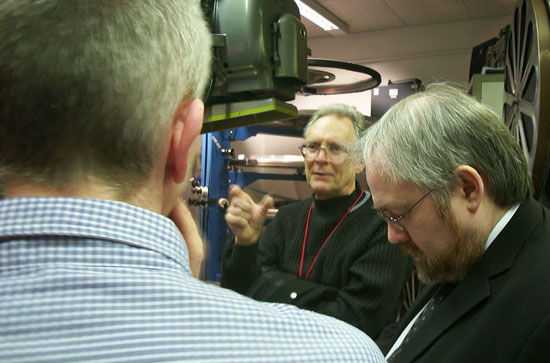 Activity
in projection making last minute decisions. Duncan McGregor
(left), Paul Rayton (middle) and Bill Lawrence (right). Picture by
Thomas Hauerslev Activity
in projection making last minute decisions. Duncan McGregor
(left), Paul Rayton (middle) and Bill Lawrence (right). Picture by
Thomas HauerslevSunday, March 23, 2003 Replaced in 2001 by a showing of "Cinerama Adventure", Sunday morning marked the return of Cineramacana. Cineramacana brings you all those little bits and pieces that lie around in people’s cupboards or on dusty shelves in archives, seldom "seeing the light of a projector" as the program note says. The day before, Bill Lawrence and I had drawn up the basic play list and we had plenty of items to choose from. Several weekend visitors had brought items along for the general enjoyment. Since it was the 50th anniversary of CinemaScope we had to push in as much anamorphic material as possible. I’d been thinking about a reel of "South Pacific" in Todd-AO on the curve, but eventually abandoned it in favor of 35mm. Imagine that I would suggest THAT! Mainly we tried to keep it to no more than 90 minutes of material, to allow time for screen change, introductions and the "Audience on Stage" picture. Eagerly Maria and I sat down to see odd bits and pieces. |
||||||||
Cineramacana running order |
||||||||
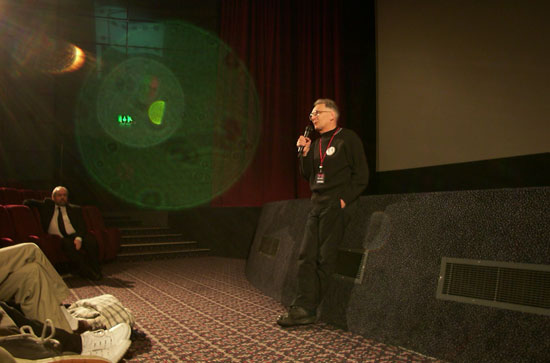 Paul
Rayton introducing short subjects. Paul
Rayton introducing short subjects. “Three Coins in the Fountain” (mono 2,35:1) “The Egyptian” (mono 2,35:1) First reel of “Interpol” (bw + mono 2,35:1) “The Face” (mono 2,35:1) Tony Sloman intro First reel of “Seven Brides for Seven Brothers” “California Holiday” (1966) (mono 2,35:1) Elvis “Speedway” (1968) (mono 2,35:1) Elvis Building of SS France intro Serge (mono 2,35:1) “Mr. Magoo Goes West” cartoon. (mono 2,35:1) intro Paul Rayton Full image with longer focal length lens to ensure full 2,55:1 width on screen: “Man in the Grey Flannel Suit” (4 trk mag 2,55:1) “Miracle of Stereo Sound” (4 trk mag 2,55:1) “Volcanic Violence” (4 trk mag 2,55:1) |
||||||||
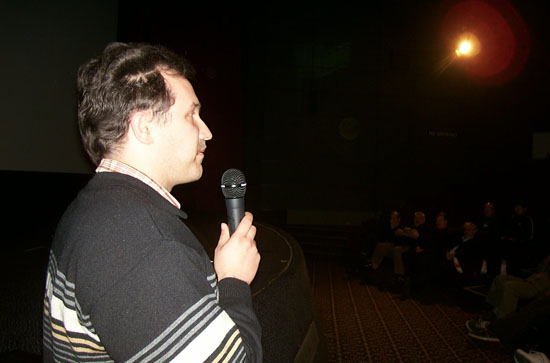 Serge
Bosschaerts introducing the French short about the building of the
"France". Picture by Thomas Hauerslev Serge
Bosschaerts introducing the French short about the building of the
"France". Picture by Thomas HauerslevBill Lawrence introduced the first three trailers. Before they began Bill introduced Mr. Sheldon Hall who announced a "Widescreen Conference" to be held at Pictureville from July 10-13, 2003. More than 30 papers on different subjects will be presented. Among several film titles, "How the West Was Won" (Cinerama) and "Porgy and Bess" (35mm) will be shown. Tony Sloman, film editor and historian was next in line to introduce and give some background for what he had brought along including the full first reel of "Seven Brides for Seven Brothers" and two Elvis Presley trailers. Then came an amazing French short film titled: "France, Naissance d´un Grand Transatlantique" ("France, Birth of a Great Atlantic Liner"), about the building of the passenger ship "France". Mr. Serge Bosschaerts of Belgium introduced it. For the DP70 enthusiast there were shots from the projection crew threading the machines aboard the ship. "France" was one of the few, if not the only, passenger ship equipped with the DP70. The short film received massive applause from the audience. Mr. Paul Rayton was next in line with introductions to an early CinemaScope cartoon about how "Mr. Magoo Goes West". Following Mr. Magoo were three 4-track magnetic stereo 2,55: 1 short subjects. Paul explained how a longer focal length lens was used in order to show the whole image in the screen. Essentially, a letterboxed CinemaScope. One of these, "The Miracle of Stereophonic Sound", was a 10-minute demonstration film mad by 20th Century Fox in 53 or 54 to illustrate stereo sound to theatre owners and possibly real audiences of the day as well. Somewhat faded but a priceless relic of the era. |
||||||||
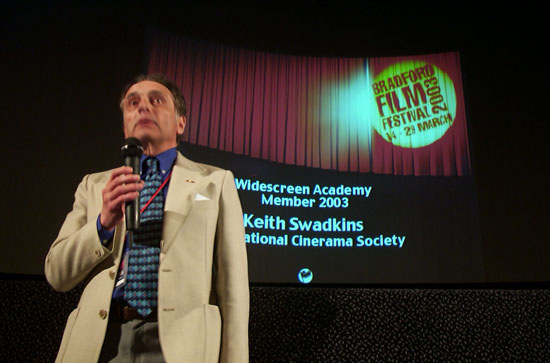 Keith
Swadkins introducing Cinerama. Picture by Thomas Hauerslev Keith
Swadkins introducing Cinerama. Picture by Thomas HauerslevAfter a brief intermission and screen change from flat to curve, I took the microphone and announced the next nominee for membership in the Academy of the Wide Screen Weekend. The group had a list of nominees and this morning we announced Mr. Keith Swadkins to be the next member of this select group. Thanks to Keith’s enthusiasm and hard work with The International Cinerama Society, 3 cinemas worldwide are once again equipped with projectors, sound and screen for the s-strip Cinerama. Mission accomplished and an achievement, which has thus to be honored. Keith was asked to introduce the "Renault Dauphine" commercial in Cinerama. He told the audience the back ground of this particular film. A few years ago Renault in France was asked about the film, and they had no idea such a film even existed. The advert has been shown from time to time at Pictureville and Renault has never protested. And why should they. It's an advert for their company showing cars being produced on the assembly line. |
||||||||
 Not
everyone wants to be a part of the picture on stage. Frank Stobbe (right)
prefer to videofilm the action. Picture by Thomas Hauerslev Not
everyone wants to be a part of the picture on stage. Frank Stobbe (right)
prefer to videofilm the action. Picture by Thomas HauerslevThe final item on the agenda was the traditional "Audience on Stage" picture. Once again photographed by yours truly and expertly choreographed by Paul Rayton, more than 80 members of the audience accepted the invitation to have their picture taken on stage in front of the massive Cinerama screen. This unique picture is available for purchase for only 10 Euros through the in70mm.com web site. |
||||||||
Coming to and End |
||||||||
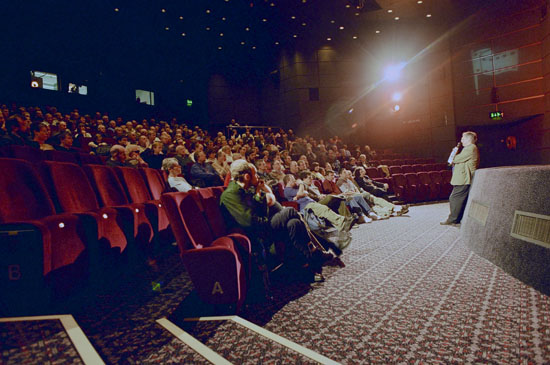 Tony
Sloman gives one of his many introductions. Picture by Thomas Hauerslev Tony
Sloman gives one of his many introductions. Picture by Thomas HauerslevOur two final films of the day were "Silk Stockings" (1957) and "Cinerama Holiday". Tony Sloman introduced "Silk Stockings" by asking how many of the audience who had seen the film originally, and there were quite a few. I wasn’t in that group of course; as a matter of fact I’d only seen it on TV in the 1970s and more recently on LaserDisc. In any case, being a sucker for film musicals, I’ve always enjoyed it and looked forward to seeing it again, but this time on the big screen. Sadly it was a faded and somewhat scratched print in mono sound, much to the frustration of Tony. Never mind, it was great; music was fabulous and those Syd Charisse legs! Stunning. The audience laughed a lot during that enjoyable show and even applauded after THE song; "Technicolor, CinemaScope and Stereophonic Sound". |
||||||||
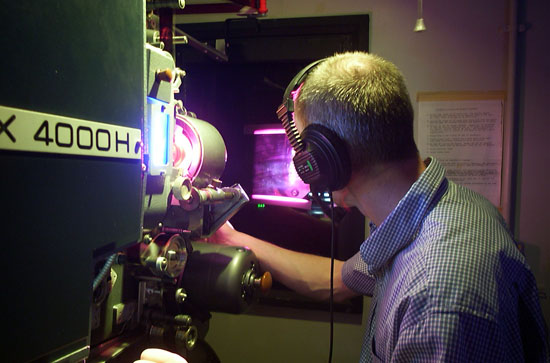 Duncan
McGregor projecting Cinerama from A-projection room. Picture by Thomas
Hauerslev. Duncan
McGregor projecting Cinerama from A-projection room. Picture by Thomas
Hauerslev.Directly after "Silk Stockings" Maria and I saw "Cinerama Holiday" again sitting on the first row. This was the last performance in Bradford for a while since the print is going back to John Harvey in America. Nothing much to report about the presentation as it was also shown last year. The cinema was about 33% full, so perhaps it’s time for a Cinerama holiday? |
||||||||
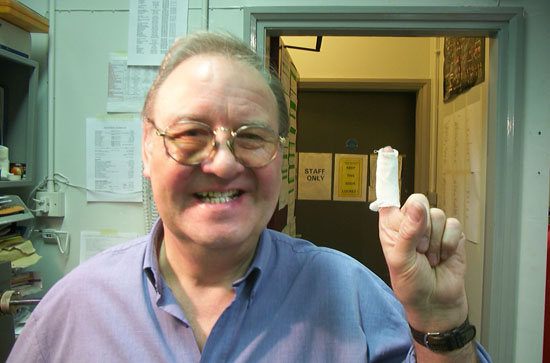 Projecting
movies is a dangerous business. Just ask Tony Cutts. Picture by Thomas
Hauerslev. Projecting
movies is a dangerous business. Just ask Tony Cutts. Picture by Thomas
Hauerslev.The weekend soon came to an end for Maria and I. On the whole I felt 2003s program was interesting but also a bit disappointing without the 70mm en-masse we are used to. I can only blame myself for this. I know several who felt the same, and the Norwegian delegation didn’t even bother to attend this year. On the other hand, however, it left more time for breaks, so in the end it was a good weekend to bring my daughter. For anyone else considering doing so, I can also recommend bringing your children. Maria soon felt at home at Pictureville and she played around during intervals. I don’t think they should be younger than 8, however, and it’s certainly a great advantage if they enjoy seeing films. |
||||||||
 Richard Greenhalgh
and Keith Swadkins. Richard Greenhalgh
and Keith Swadkins.I spent time with Bill Lawrence during John Belton’s CinemaScope lecture to talk about what to show next year. We both have ideas, one of which is to celebrate the 50th anniversary of VistaVision and Technirama. In 2004 the weekend will start Thursday night and go on until Monday morning expanding the event by one day into 5 days. My 2004 and 2005 personal dream programs right now would look like this, but if I were you, I would expect a lot of changes. Maria and I were back in Denmark late Monday evening and were picked up at the airport by the rest of the family. It felt good to be back. |
||||||||
|
Go: back
- top - back issues
- news index Updated 22-01-25 |
|
|||||||
